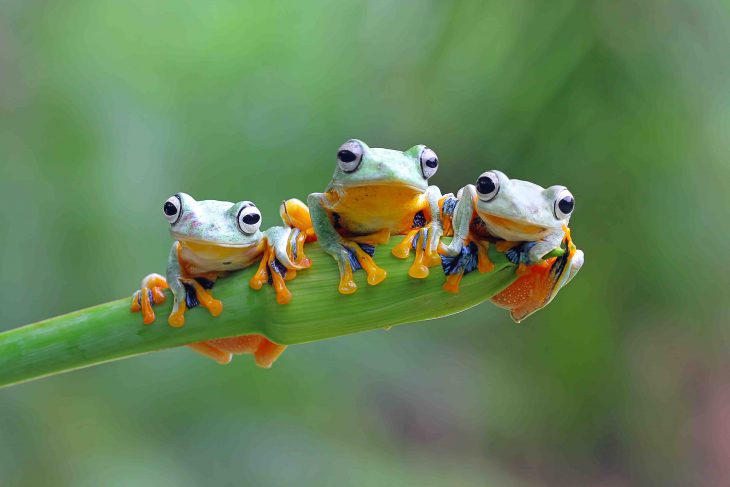
One of the most common animals seen in the world are frogs. Despite their size, frogs are considered to be quite the opponent in the wild due to their excellent survival and camouflage skills. Frogs are also an important part of the food chain as they are both the predator and prey. Find out more about these cute and slimy creatures with our collection of frog facts.
- Since the 1970s, over 200 frog species have been considered to be extinct.
- As of 2015, there are over 6000 different frog species that have been discovered.
- Frogs have 3 distinctive cavities in their bodies that host their organs.
- The liver of a frog contains 3 lobes which help secrete its digestive juices called bile.
- Frogs can hold their breath for an average of 4 to 7 hours at a time.
- Frogs lay their eggs in the water much as toads do.
- The Goliath Frog is said to be the largest species of frogs in the world.
- Frogs and toads are not considered to be the same animal but are considered to be similar.
- The smallest frog species in the world is known as the Paedophryne amanuensis.
- The largest organ in the body of a frog is its liver.
- Many frogs have special toe pads that allow them to stick onto surfaces without falling.
- In some eastern countries, frogs are typically consumed as street food or in prepared dishes.
- The skin of a frog can vary in color from green, brown, black, orange, blue, and many others.
- Frogs are classified as social animals that typically live in groups referred to as an army.
- Frogs have two slits at the bottom of their mouths that allow them to croak with their vocal cords.
- Many frogs will bite you if they feel threatened or unsafe.
- The common frog is capable of crying.
- There are approximately 170 different types of poison dart frogs.
- The tongue of a frog is typically ⅓ of the length of its body.
- Around 466 frog species are classified to be critically endangered.
The male Darwin’s frog swallows its tadpoles and stores them in its vocal cords.
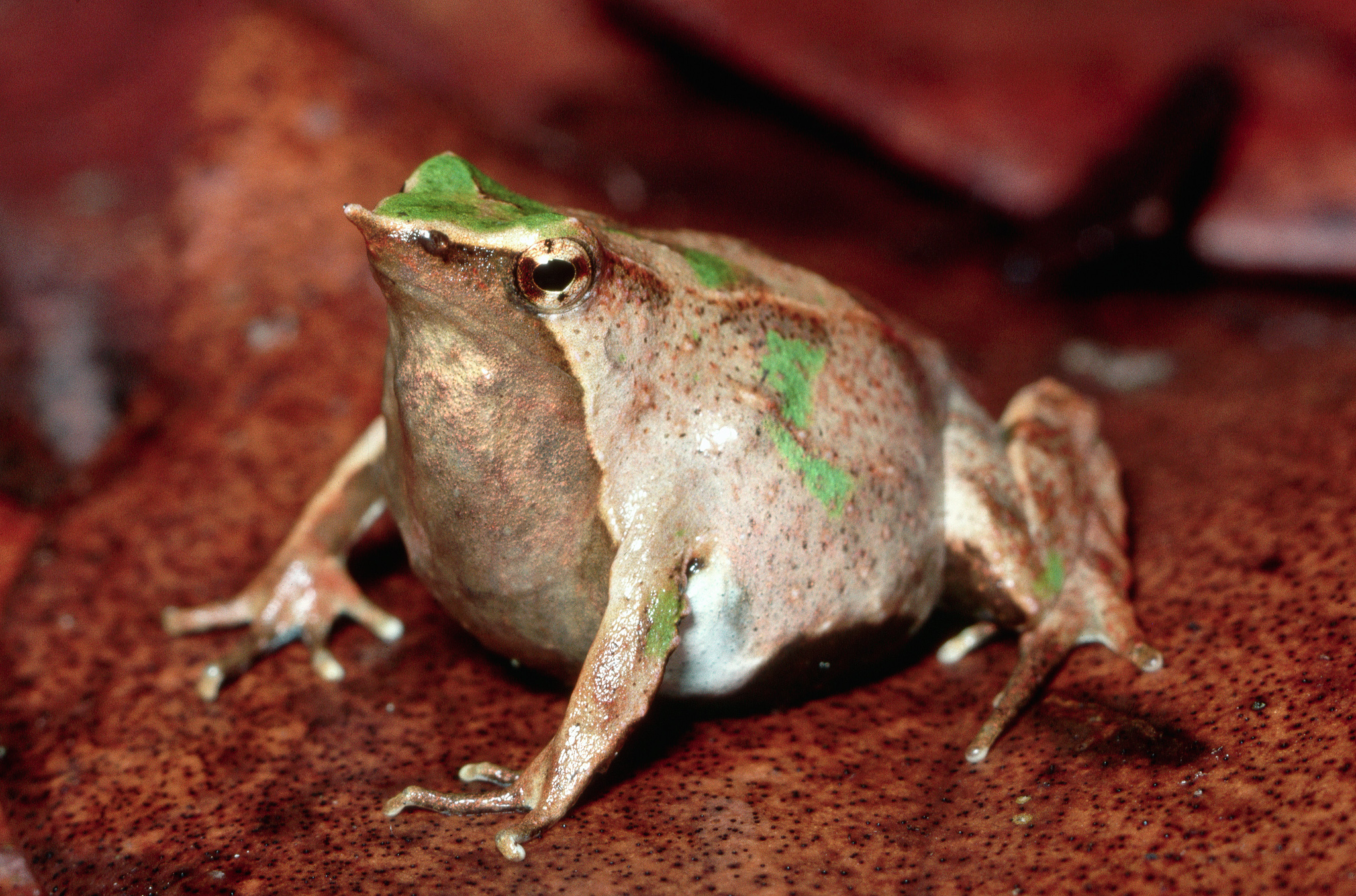
The Darwin’s frog is a small frog species that are typically classified by their elongated snout which gives their head a triangular appearance. When a female Darwin’s frog lays its eggs, the male will guard them for a period of 3 to 4 weeks by storing them in its vocal cords until the embryos begin to move.
The tadpoles inside the male frog will feed off of their egg yolks and other secretions that are produced by the wall of the vocal sac until the stage of metamorphosis. Once this stage has been reached, the tadpoles will have turned into frogs by then and jump out of their father’s mouth and disperse.
One frog species found in Indonesia has been found to have no lungs to breathe with.

The Bornean flat-headed frog is classified as an endangered frog species that originate from the rainforests of Indonesia. This frog species is also believed to have evolved from the plethodontid salamanders that originate in Mexico and have been discovered to have no lungs inside of their bodies.
The red-eyed tree frog is known to lay its eggs underneath leaves that hang over bodies of water.
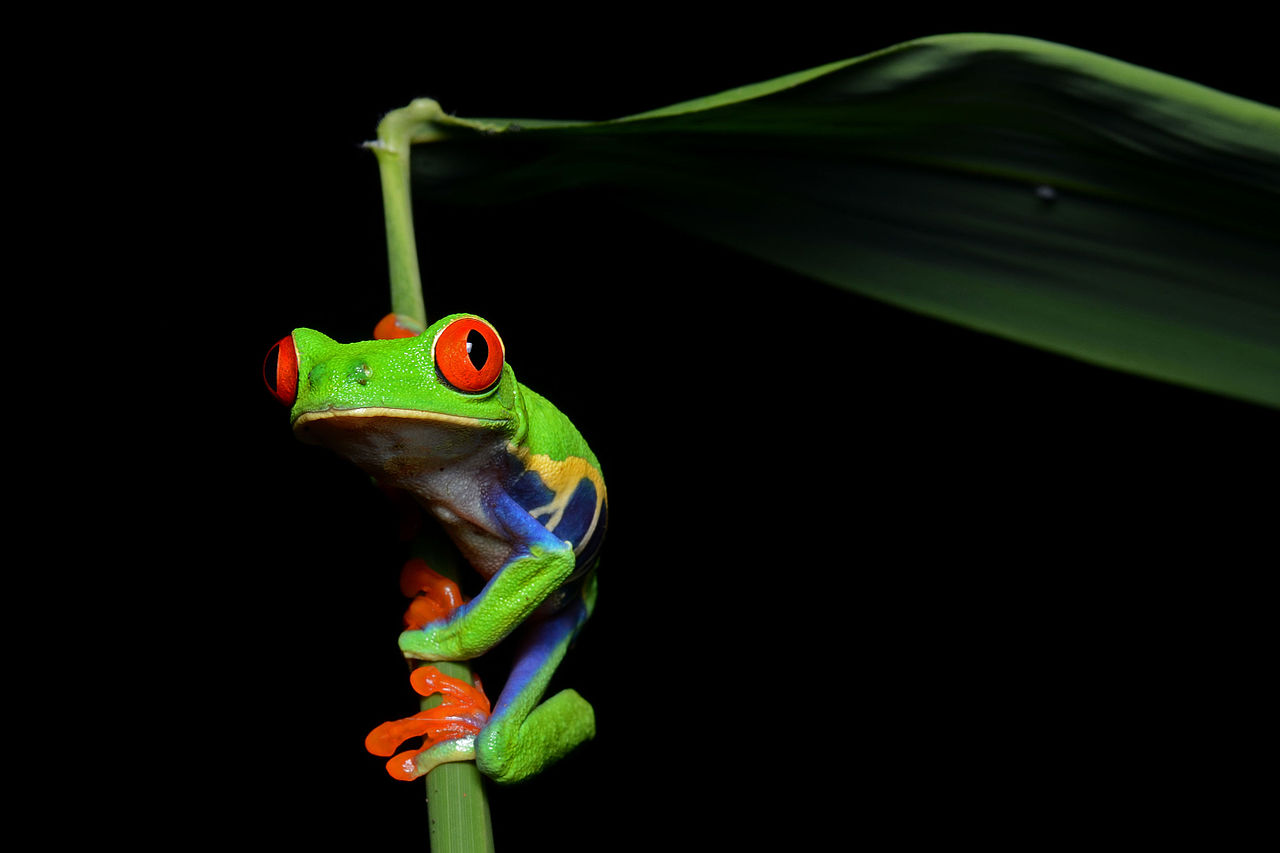
According to research, red-eyed tree frogs typically mate through October until March of the next year and are usually done by a male attracting a female of its species by croaking. When the eggs of this species hatch, the fluid found inside the eggs allow the tadpoles to be washed into the water below them.
Once the eggs have hatched, the tadpoles take about an average of 14 weeks until they develop limbs and organs and become small frogs. The red-eyed tree frog is more commonly known for its bright green skin and vivid red eyes with vertical pupils similar to that of a snake.
Most frogs can jump over 20 times their height while some may be able to jump even higher.
Frogs are best known for their outstanding jumping ability granted by their long and powerful legs which are often used to escape predators in the wild. The frog species that holds the world record for the highest jump belongs to the South African sharp-nosed frog which has an average body length of 3 inches and can jump over 130 inches in a single leap or jump.
However, despite the jumping abilities of these creatures, not all species of frogs can jump as high as other species due to some of them having shorter legs than others. If a person was to jump this high, the average 5-foot tall person would need to jump over 220 feet in a single leap.
Mother frogs typically spend months feeding each of their tadpoles until they can provide for themselves.
According to research, several species of frogs create nests out of foam for their eggs which keeps them safe from diseases and prevents the development of fungus. These nests are often made under leaves and over a body of water so that when it is time for the eggs to hatch, the tadpoles can fall into the water immediately.
During the first few weeks after hatching, the mother frog typically feeds each of its tadpoles with different types of algae from plants and surfaces. Additionally, tadpoles are also able to eat other decaying animals, plants, and on rare occasions, other frog eggs as well for the necessary nutrition they need to grow.
A small amount of poison from the Golden Poison Dart Frog could kill thousands of people.

The golden poison dart frog is considered to be one of the most deadliest and poisonous animals on the planet. The poison of this frog species comes from their skin which makes them deadly to touch with your bare hands as the skin can absorb the poison on the frog’s body.
The poison from this frog often causes nausea, swelling to the infected area, and as well as a paralyzing effect on the body’s muscles. The poison that comes from the golden poison dart frog is said to be strong enough to kill a grown man within 10 minutes from the initial exposure to the body’s bloodstream.
The glass frog is famous for its translucent and beautiful skin that seems like glass.
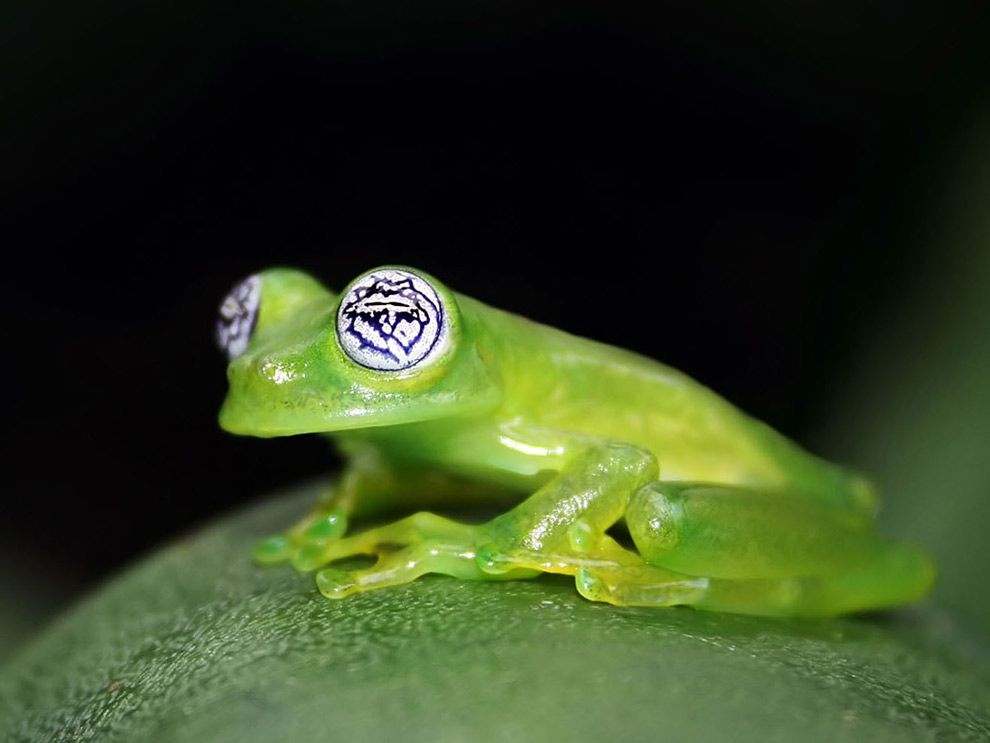
The Guajira Giant Glass frog is well-known for being one of the few glass frogs that share transparent skin types. According to research, the reason why these creatures have transparent skin is still unknown.
However, it is believed that this unique skin type may be due to evolutionary survival which helps these creatures hide from predators in the wild by blending into their surroundings much like a chameleon does when it changes its skin color. Glass frogs can typically be found in Southern Mexico and as well as in the Central and South America regions where there are around 60 different types of glass frog species.
In some cases, the gender of a frog can be determined by looking at its ears.
Female and male frogs typically have different sized markings on their ears which is known as the tympanum which often helps us in determining their gender more simply. In the majority of frog species, male frogs typically have larger ears while females have smaller sized ones.
Additionally, the gender of a frog can also be determined by their body size, nuptial pads on their hands, and as well as if they sing or not. Other factors such as skin color and how loose their skin is can also help others determine if a frog is a boy or a girl.
Frogs typically have longer legs compared to toads because they are made for jumping.
One of the easiest ways to determine if these amphibians are classified as a toad or a frog is by looking at their legs. Frogs are typically smaller and have longer legs used for jumping which allows them to escape from prey and move around locations quicker.
On the other hand with toads, their legs are typically shorter and they hop around from one place to the other instead of jumping taller heights. Additionally, frogs and toads can also be differentiated by their skin when frogs tend to have more moist-looking skin while toads typically have dry and hard looking skin types.
Most common frog species have teeth on their upper jaw.
Typically, frogs will have teeth located on the upper part of their jaw which help them while hunting and consuming their prey. One species of frog is noted to have teeth in either jaw however and it is known as the Gasthrotheca Guentheri frog which is native to South America.
Despite typically swallowing their prey whole, some frogs will use their teeth to help chew down their food to swallow better. The teeth found on the upper jaw of a frog are referred to as the Maxillary teeth and some frogs will also have small teeth on the roof of their mouths called the vomerine teeth.
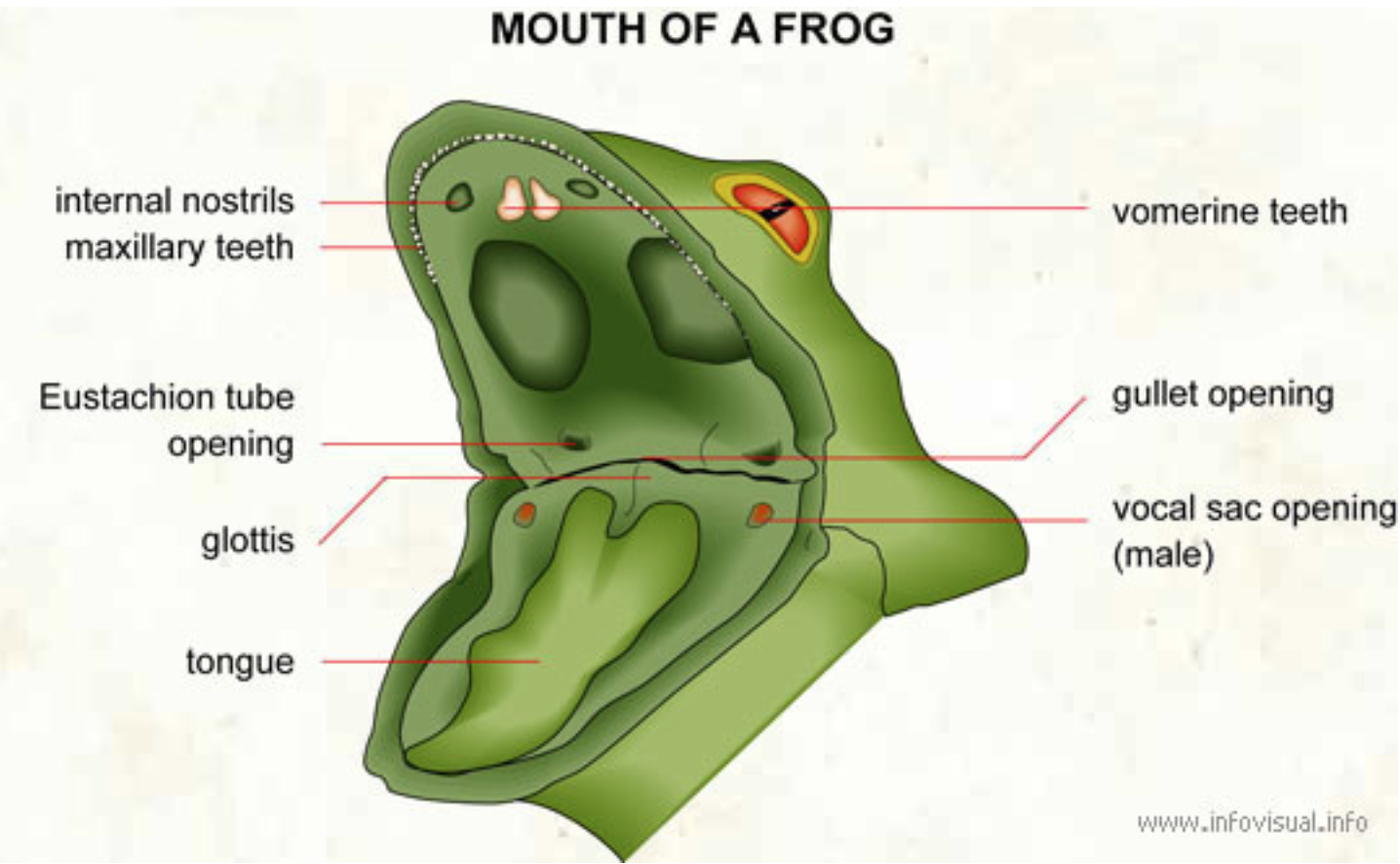
Poisonous frogs attain their poison through eating mites, ants, and other insects.
According to research, a few poisonous frog species obtain their poison traits from the foods they eat such as insects that contain toxins and chemicals within their bodies. However, these frogs can eat these insects without suffering from any type of damage towards themselves.
One of these poisonous frogs includes the blue poison dart frog whose diet mainly consists of ants and other small insects that carry toxins in their bodies from the plants that they consume before falling prey to these frogs. Lastly, depending on the species of the frog, the toxicity level of its poison may vary as well.
On average, the lifespan of a frog can last anywhere between 10 to 12 years in total.
According to statistics, the average frog typically lives for about 10 to 12 years whereas frogs that are kept in captivity may live as long as 15 years old. During this time frame, a frog will go through four different stages throughout its life where first it is an egg, followed by the tadpole stage, to a froglet, and finally as an adult frog.
Some more recent research has also shown that the Goliath frog can also live up to 15 years in the wild due to its large size while in captivity they may live as long as 21 years old.
Some frog species will also eat other smaller frogs as their source of food.
Frogs are scientifically classified as carnivorous animals which indicates that apart from insects, they may also consume other animals including other frogs. In some cases, frogs may also physically fight each other by biting and jumping onto each other.
Additionally, certain frog species may also eat their eggs and tadpoles, and as well as other frog’s offspring if they cannot find any other source of food. According to scientists, the African clawed frog favors the taste of its tadpoles compared to other prey such as insects.
A new frog species was discovered in 2020 and it is called the Lilliputian Frog.
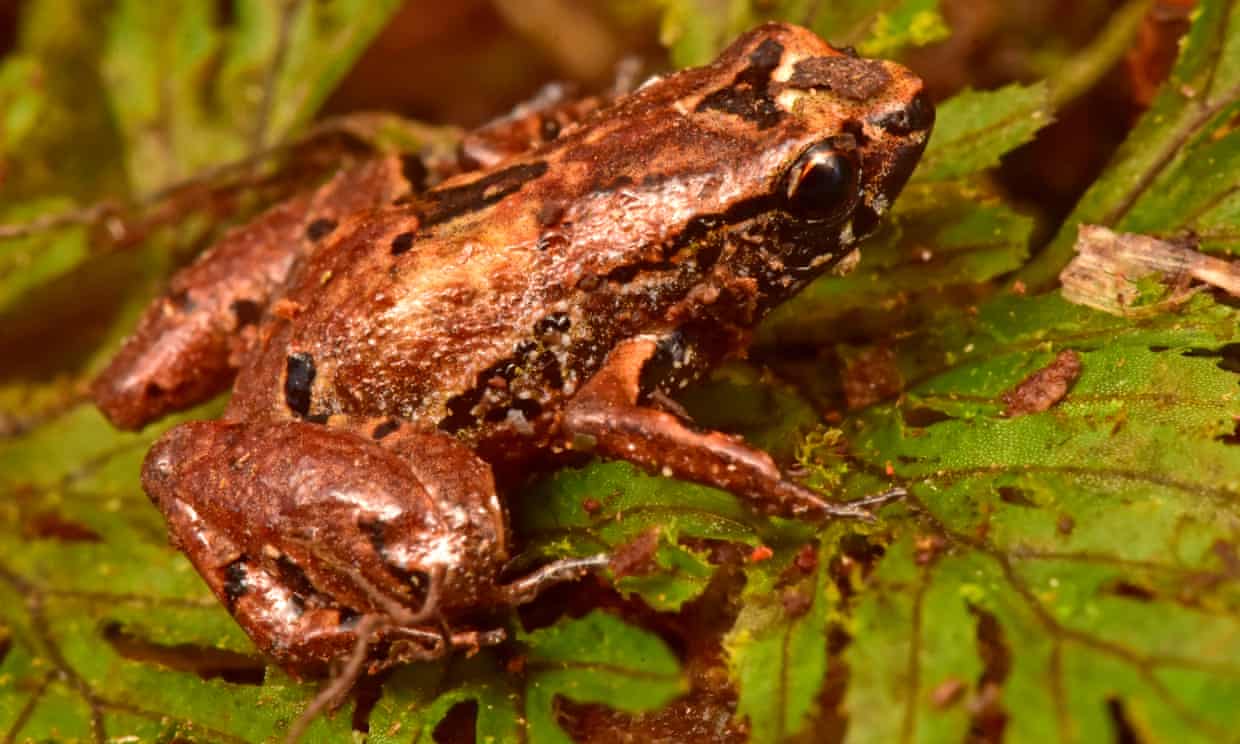
The Lilliputian frog is a newly discovered species of frog that originates from the Zongo Valley in Bolivia. This frog species is considered to be fairly small measuring 10 mm long and is considered to be talented in camouflaging itself from enemies.
According to scientists, this species of frogs is considered to be one of the smallest in the world and as well as the smallest amphibian.
Some frogs swallow their prey whole because they are incapable of chewing their food.
Not all species of frogs have teeth on their upper jaw that help them chew their food. As a result, these slimy critters usually swallow their prey whole when they hunt or when they are given food.
Frogs are equipped with long sticky tongues that allow them to quickly capture their prey and curl them down to the back of their throats to swallow whole. On average, frogs typically eat twice a day and their diets will usually consist of insects, fruits, plants, and other small creatures. Full-grown frogs can go long periods without eating whereas froglets typically need to eat daily to survive.
During each year that a frog goes into hibernation, they grow a new layer of bones.
According to scientists, the bones of a frog from a new ring each year during hibernation much similar to the way that trees grow a new ring as it ages. Additionally, these rings on their bones can, later on, be counted to determine the age of the frog in question.
During the winter, frogs typically go towards the bottom of bodies of water that are rich in oxygen where they will lie on top of the mud for the whole duration of the winter. By doing so, the frog allows the oxygen from the surrounding area to be absorbed by its skin as the rest of its body systems slow down to survive the hibernation process.
Croaking is a method used by male frogs to attract females.
Frogs have several different types of calls and sounds that they use to communicate and gain the attention of other frogs. Typically, only the males make use of these calls for courting rituals and announcing their location to defend their territory.
The sounds that a frog makes can travel clearly through the air, water, and as well as through substrate which shows how audible their calls can be. The male frog can create their croaking sounds thanks to the two slits that form in the bottom of their mouth which opens the vocal pouch that allows air to pass through and create noise.
Frogs held in captivity have been found to live longer than those who live in the wild.
Over the years, frogs have become a popular choice for exotic pets as they can be kept in simple living conditions that often come inexpensive. Pet frogs are typically fed a variety of live insects which are fairly easy to collect or buy from your local pet store.
Common species of pet frogs are Ranids and Leptodactylidae. Additionally, other species that are considered to be rarer are typically sold for a higher price than common frogs.
Having a glass frog as a pet requires an owner to meet particular conditions first.
Before someone is allowed to legally purchase a glass frog as a pet, they must first meet several requirements and understand the tedious care instructions for these slimy creatures. Glass frogs typically require large amounts of vegetation in their tanks for them to feel comfortable and avoid overstressing them.
For owners that wish to own a pair of glass frogs, a larger tank is required as they each need to feel uncrowded inside the tank. Depending on the species of the glass frog, the required size of the tank can vary as this species requires a large amount of space to be kept properly.
The study of frogs is referred to as Herpetology.
Herpetology comes from the Greek word herpeton which translates into ‘reptile’ or it can also mean ‘creeping reptile’. This study is concerned with reptiles in general including not only frogs, but newts, salamanders, reptiles, and caecilians as well.
A person who studies herpetology is referred to as a herpetologist and these people typically have a background in life sciences such as biology or zoology. On average, it takes about 4 years to complete a bachelor’s degree in this field before entering a master’s program in herpetology.
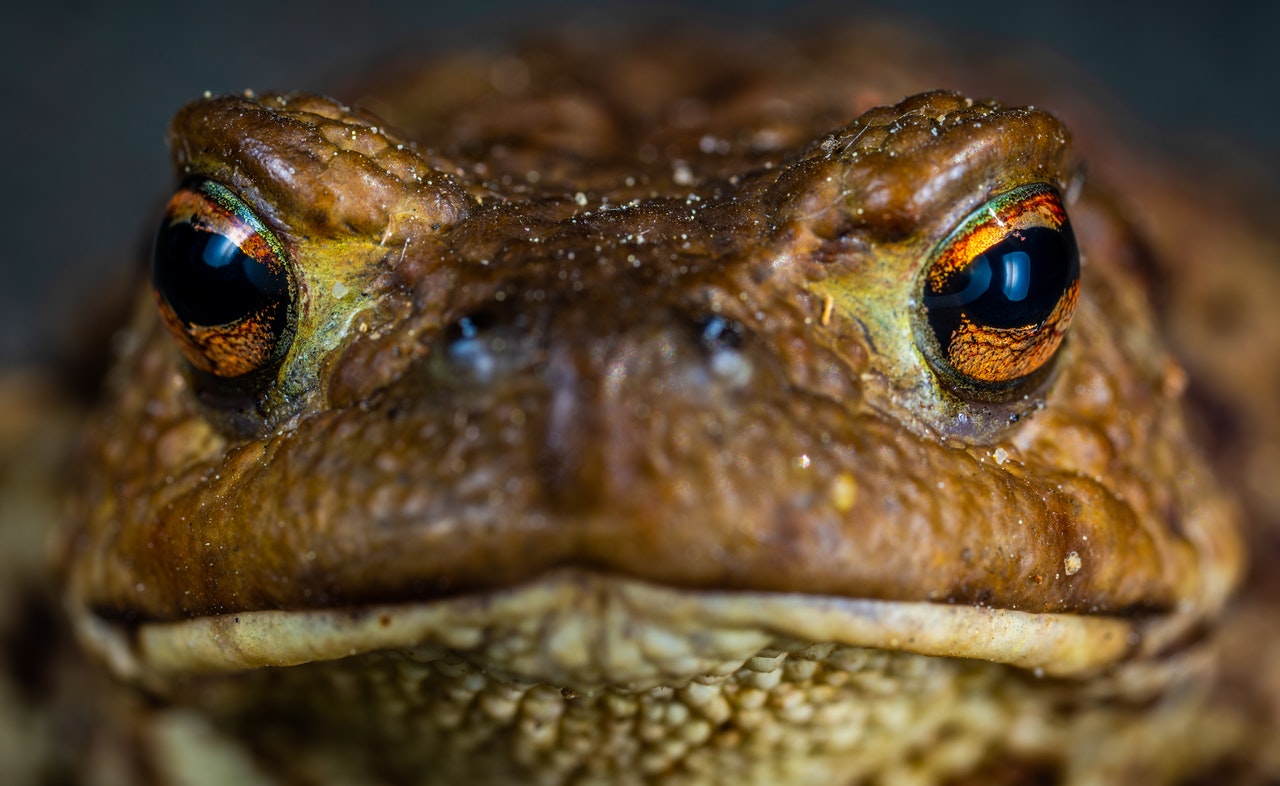
Both frogs and toads are classified as carnivores and commonly feed on insects.
Frogs and toads share many things in common such as their appearance, abilities, and other aspects including their carnivorous diets. These two species are also members of the same scientific class, Amphibia, which classify both of them as cold-blooded amphibians.
Both species also spend their early life in the water and begin from eggs and into tadpoles until they develop organs and limbs to be able to live on land. However, despite their similarities, frogs, and toads secrete different types of chemicals from their skin that can cause discomfort towards the other party and cause fights among each other or harm to their health.
New research shows that some frog species can glow in the dark under certain lighting.
A new study that was conducted in 2020 stated that both frogs and salamanders can glow in the dark under specific lighting conditions. In this study, over 32 different species of amphibians were tested to which all came out positive to be able to re-emit the light that comes from either blue or ultra-violet lighting.
This process is referred to as biofluorescence which is a phenomenon observed to be present in several other life forms as well such as jellyfishes and turtles. Scientists have also observed that not only does the skin of frogs and salamanders glow after absorbing special light, but their bones and urine does as well.
In North America, the wood frog freezes during the winter and is reanimated later in the spring.

According to scientists, the wood frog that is native to Alaska typically freezes around two-thirds of their body water into ice and causes their blood to stop flowing and their hearts to stop beating as well. However, during this occurrence their glucose levels are found to rise significantly which allows them to tolerate temperatures as low as 0 degrees celsius.
It is stated that the snow helps these frogs provide an insulated layer for themselves that allows them to stay frozen for long periods to survive hibernation and the consistently cold weather in Alaska. Once spring arrives, the frogs begin to thaw and turn as much glucose as they can from their bodies back into glycogen and urinate the excess amounts of it to be ready for mating season.
The Surinam toad is known to lay up to a hundred eggs at a time.
The Surinam toad is known to have a special method of mating compared to other frog species. Typically, the male frog will call the attention of the female by creating clicking sounds underwater until a female approaches it and releases around 60 to 100 eggs.
As the eggs are released, the male frog will fertilize them and push the eggs onto the back of the female which will allow them to stick firmly on. Once the eggs on the female’s back hatch, these frogs will begin a life of solitude again until it is time to mate once more. On average, it takes around 105 days for metamorphosis.
The majority of frog species are considered to be good swimmers due to their amphibious traits.
Frogs and toads often swim in a similar manner where it can be compared to the breaststroke that humans use at times to swim. Frogs will draw their hind legs up towards their bodies and propel themselves forward by kicking out their legs and repeating the process to continuously swim around in a straight line.
Because these creatures are amphibious, frogs still need air to breathe which means that they might drown if they allow their lungs to be filled up by water. However, frogs typically breathe by absorbing the oxygen found in the water, if there is no oxygen to be found where they are swimming they will not be able to breathe.
Frogs can start breeding once they reach between 2 to 3 years of age.
When frogs begin to mate, it takes the female around an average of 4 days to lay its eggs before it can leave the water. After mating with a female, the male frog immediately looks for another female to mate with and will continue this pattern until the mating season passes.
Frogs typically begin mating as soon as they come out from hibernation which explains why the sign of spring typically indicates loud singing coming from frogs in forest areas and ponds. They come out when rain and melting snow begin to create puddles which will help keep their bodies in a temperature above freezing point.
Frog ears are sensitive exclusively to sounds they need to hear to survive.
Scientists have discovered that frogs rely on their hearing solely for distinguishing other frogs and as well as their predators. Apart from this function, it seems that the brain of the frog does not react to anything other than acoustic patterns that are needed to distinguish as a means to survive.
Some studies determine that this may be due to the lack of physical ears that frogs have despite having ear holes that are located right behind their eyes.
Frogs typically shed their skin once a week and eat the shredded skin afterward.
Despite how strange it may sound, frogs routinely do this as a means of not wasting precious protein found in the shredded skin ratchet than just leaving it behind to rot or taken by other animals. When a frog sheds, it pushes all the skin towards its mouth to make the process faster and easier to consume at the same time.
According to research, older frogs will shed their skin around four times each year while younger frogs will tend to shed their skin more often every few weeks or so and some as often as daily for some species.
The waxy monkey frog can secrete wax from its neck to moisturize itself.
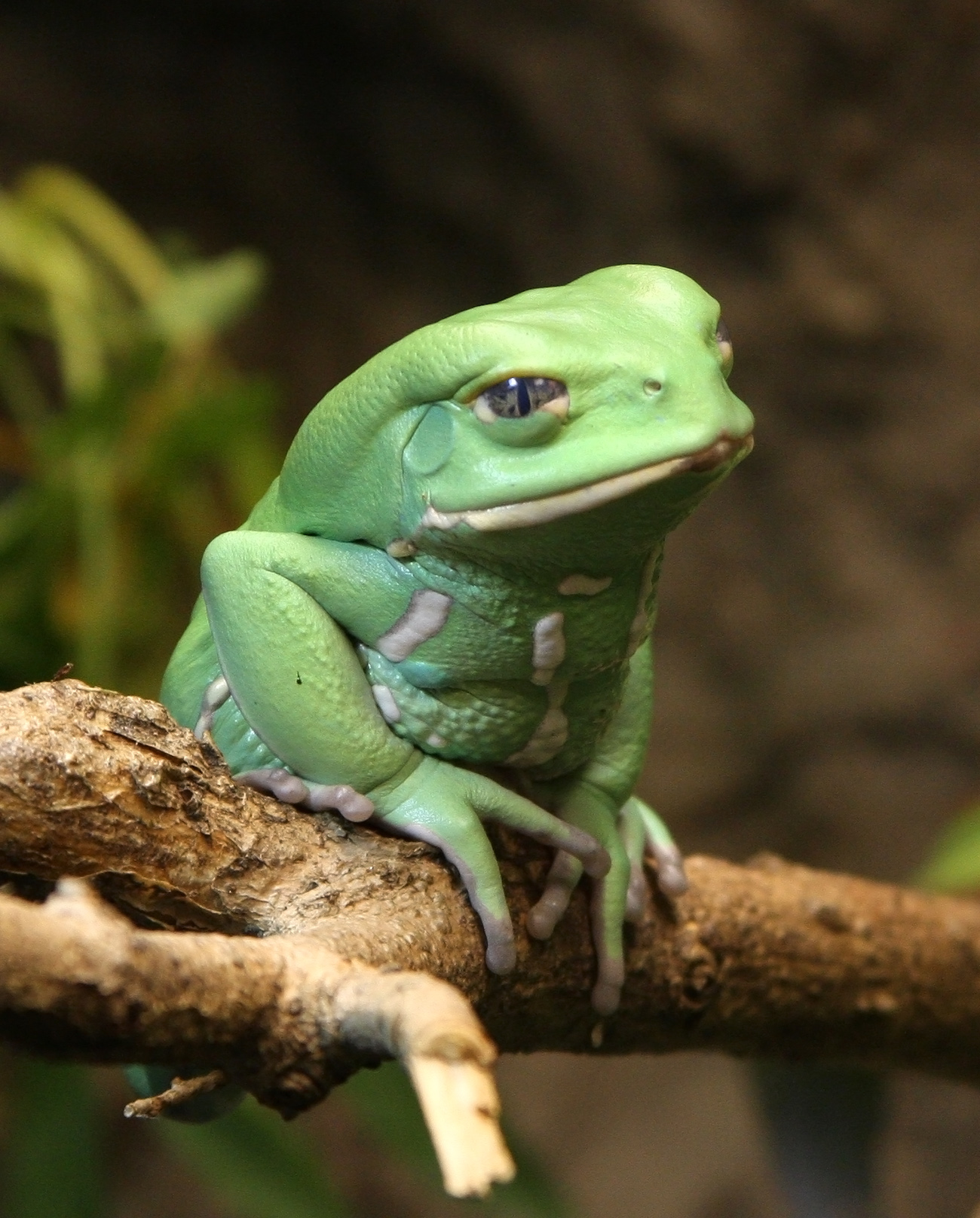
Also scientifically known as the Phyllomedusa sauvagii, this frog species is unique from others as it is the only frog that can create wax. This frog species is native to South America and can also be found in other places such as Bolivia, Brazil, and as well as Paraguay where it breeds during the rainy seasons of the year.
The wax that these frogs produce is also considered to be poisonous to other creatures which means that they can be deadly to the touch as this wax is spread around its body to moisturize itself. Thanks to this trait, this acts as a strong defense mechanism against predators and other creatures.
Frogs drink water through their skin.
Frogs have a special feature in their bodies called a ‘drinking patch’ which they use to absorb water through their skin. This gland is located right at the underside of the frog’s stomach and thighs.
For people taking care of frogs, water given to these little critters must be dechlorinated and placed into a bowl that they can easily come in and out from. Additionally, they must not be given tap water as this could kill them otherwise due to the possible chemicals that may come from the pipes or the water source of the tap water.
Was this page helpful?
Our commitment to delivering trustworthy and engaging content is at the heart of what we do. Each fact on our site is contributed by real users like you, bringing a wealth of diverse insights and information. To ensure the highest standards of accuracy and reliability, our dedicated editors meticulously review each submission. This process guarantees that the facts we share are not only fascinating but also credible. Trust in our commitment to quality and authenticity as you explore and learn with us.
